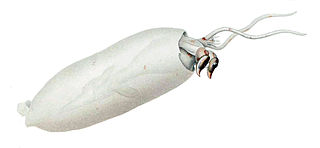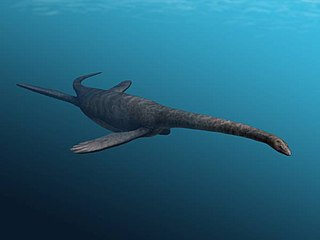
The Mastigoteuthidae, also known as whip-lash squid, are a family of small deep-sea squid. Approximately 20 known species in six genera are represented, with members found in both the mesopelagic and bathypelagic zone of most oceans. Originally described by Verill in 1881, it was later lowered by Chun (1920) to a subfamily (Mastigoteuthinae) of the Chiroteuthidae. However, Roper et al. (1969) raised it back to the family level, and this has not been changed since. The taxonomy of this family is extremely unstable, and there have been at times one genus, two genera and four subgenera(Salcedo-Vargas & Okutani, 1994), two genera and several 'groups', five genera and one species with an uncertain placement, or six genera.

Taoniinae is a subfamily containing ten genera of glass squids.

Velodona togata is a species of octopus in the monotypic genus Velodona. First described by Carl Chun in 1915, with a second subspecies discovered by Guy Coburn Robson in 1924, it was named for the distinctive membranes on its arms.

Miodentosaurus is a genus of thalattosaurian from the Late Triassic of China. It is one of several thalattosaurs found in the Xiaowa Formation, also known as the Wayao Member of the Falang Formation. The genus name "Miodentosaurus" translates to "Few toothed-lizard" while the species name "brevis" means "short", in reference to its short snout.
Blinasaurus is a name of an extinct genus of prehistoric brachyopid found in Triassic geological formations of Australia. The type species is Platyceps wilkinsonii Stephens, 1887. The genus was established by John W. Cosgriff in 1969 to incorporate the type, discovered in New South Wales, and the author's new fossil species, Blinasaurus henwoodi, describing type material found in Blina Shale in the Kimberley region of northwest Australia.
Juchilestes is an amphidontid mammal genus from the early Cretaceous. It lived in what is now the Beipiao of western Liaoning, eastern China. It is known from the holotype D2607, which consists of three-dimensionally preserved, partial skull with mandibles and some teeth. It was found in 2004 from the Lujiatun Site of the Yixian Formation. It was first named by Chun-Ling Gao, Gregory P. Wilson, Zhe-Xi Luo, A. Murat Maga, Qingjin Meng and Xuri Wang in 2010 and the type species is Juchilestes liaoningensis.
Shantungosuchus is an extinct genus of Early Cretaceous crocodyliform found in China. It includes three species: Shantungosuchus chuhsienensis and S. brachycephalus, which were both described by Yang Zhongjian – usually referred to as "Young" – in 1961 and 1982, and S. hangjinensis, which was described by Xiao-Chun Wu et al in 1994. S. chuhsienensis is the type for this genus.

Sinosaurosphargis is an extinct genus of basal marine saurosphargid reptile known from the Middle Triassic Guanling Formation of Yunnan and Guizhou Provinces, southwestern China. It contains a single species, Sinosaurosphargis yunguiensis.
Sikannisuchus is an extinct genus of large archosaur from upper Triassic deposits of northeastern British Columbia, Canada. It is known from the holotype, TMP 94.382.3, a posterior portion of skull roof and from other fragmentary remains. It was found from four localities of the Pardonet Formation, near the community of Sikanni Chief. It was first named by Elizabeth L. Nicholls, Donald B. Brinkman, and Xiao-Chun Wu in 1998 and the type species is Sikannisuchus huskyi. It would have reached about 4 metres (13 ft) in length. Ichthyosaurs such as Macgowania, Callawayia and possibly the giant shastasaurid Shonisaurus, coelacanths Whiteia banffensis and possibly Garnbergia, and various genera of molluscs including ammonites and bivalves have also been found in the Pardonet Formation.
Diandongosaurus is an extinct genus of eosauropterygian known from the lower Middle Triassic of Yunnan Province, southwestern China. It is known from the holotype IVPP V 17761, a complete and articulated skeleton with skull, which was found in the middle Triassic Lagerstätte of the Guanling Formation. It was first named by Qing-Hua Shang, Xiao-Chun Wu, Chun Li in 2011 and the type species is Diandongosaurus acutidentatus. A referred specimen suggests a total body length of 34 cm (13 in).

Prayidae is a family of marine invertebrates in the order Siphonophorae. They are colonial, and the colonies can superficially resemble jellyfish; although they appear to be a single organism, each specimen is actually a colony of Siphonophora.

Yunguisaurus is an extinct genus of pistosaur known from the Guizhou Province of China.

Matoniaceae is one of the three families of ferns in the Gleicheniales order of the Polypodiopsida class. Fossil records reveal that Matoniaceae ferns were abundant during the Mesozoic era, during which they lived on every continent, including Antarctica, with eight genera and 26 species, with the oldest known specimens being from the Middle Triassic of Antarctica. Today the family is much less abundant, and also less diverse, with only two extant genera and four species, which are limited to portions of southeastern Asia.

Sinocyamodus is an extinct genus of placodont reptile from the Late Triassic (Tuvalian) Xiaowa Formation of China. Only one species, Sinocyamodus xinpuensis, is currently assigned to this genus. This genus was the first placodont to be discovered in the eastern Tethys, overthrowing traditional views that the group was restricted to the western Tethys.

Saurosphargidae is an extinct family of marine reptiles known from the Early Triassic and early Middle Triassic of Europe and China.
Saurosphargis is an extinct genus of a basal marine reptile, saurosphargid, known from the Middle Triassic of southwestern Poland and eastern Netherlands. It contains a single species, Saurosphargis volzi.

Triconodon is a genus of extinct mammal from the Early Cretaceous of England and France with two known species: T. mordax and T. averianovi. First described in 1859 by Richard Owen, it is the type genus for the order Triconodonta, a group of mammals characterised by their three-cusped (triconodont) molar teeth. Since then, this "simplistic" type of dentition has been understood to be either ancestral for mammals or else to have evolved multiple times, rendering "triconodonts" a paraphyletic or polyphyletic assemblage respectively, but several lineages of "triconodont" mammals do form a natural, monophyletic group, known as Eutriconodonta, of which Triconodon is indeed part of.

Protoalligator is an extinct genus of alligatoroid crocodilian found in the Anhui province of China and lived during the Paleocene.

Abylopsis is a siphonophore genus in the Abylidae. The genus contains bioluminescent species.
Brevicaudosaurus is an extinct genus of nothosauroid marine sauropterygian from the Middle Triassic of China. The type species is B. jiyangshanensis. It was a small animal, with specimens measuring approx. 40 cm long in total length. It had a broad, flat body, with an unusually short and flattened tail compared to other nothosaurs, which indicates that it could not swim quickly and was probably adapted to a way of life as a benthic carnivore. The holotype, IVPP V 18625, was prepared by Y.-F. Chen.










